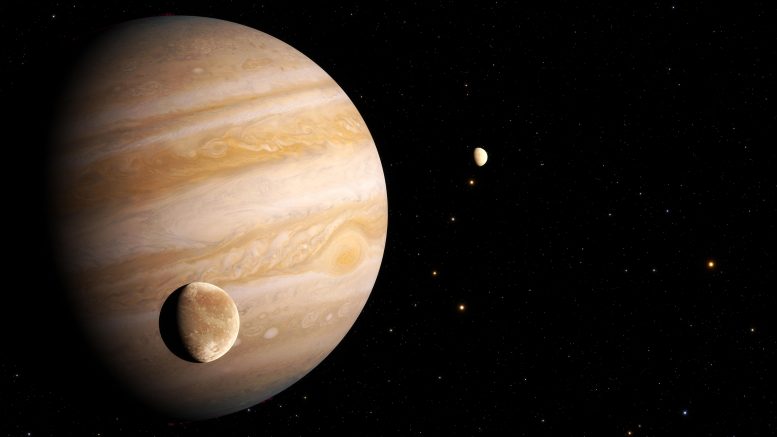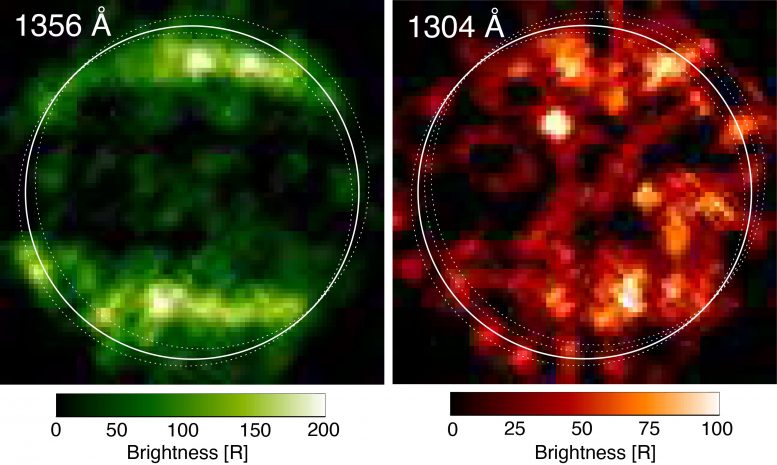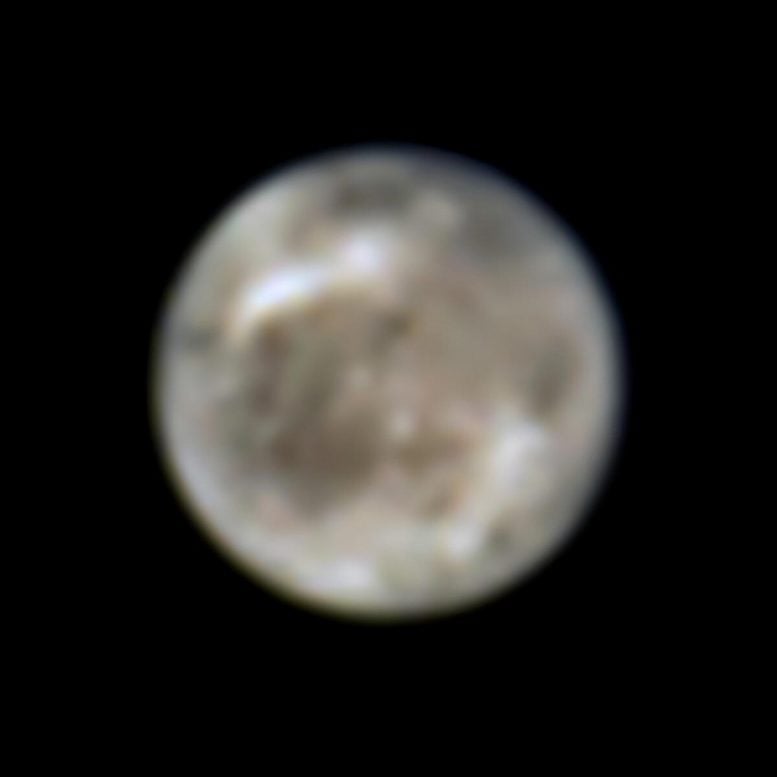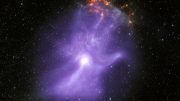
This image presents an artist’s impression of Jupiter’s moon Ganymede. Astronomers have used archival datasets from the NASA/ESA Hubble Space Telescope to reveal the first evidence for water vapor in the atmosphere of Jupiter’s moon Ganymede, the result of the thermal escape of water vapor from the moon’s icy surface. Credit: ESA/Hubble, J. daSilva
Oxygen Found on the Frozen World Is Linked to Sublimating Surface Ice
Though larger than the blistering planet Mercury, the Jovian moon Ganymede is no place to go sunbathing. Located ½-billion miles from the Sun, the water ice on its surface is frozen solid in frigid temperatures as low as minus 300 degrees Fahrenheit. This makes the ice as hard as rock. Still, a rain of charged particles from the Sun is enough to turn the ice into water vapor at high noon on Ganymede. This is the first time such evidence has been found, courtesy of the Hubble Space Telescope’s spectroscopic observations of aurora on Ganymede spanning two decades. The auroras are used to trace the presence of oxygen, which then is linked to the presence of water molecules sputtering off the surface. Ganymede has a deep ocean located an estimated 100 miles below the surface. That’s too deep for water vapor to be leaking out.
Astronomers have used new and archival datasets from NASA’s Hubble Space Telescope to uncover evidence of water vapor in the atmosphere of Jupiter’s moon Ganymede. The vapor is present due to the thermal excitation of water molecules from the moon’s icy surface. Previous research has offered circumstantial evidence for the moon containing more water than all of Earth’s oceans. However, temperatures there are so cold that water on the surface freezes and the ocean lies roughly 100 miles below the crust. Credit: NASA’s Goddard Space Flight Center
For the first time, astronomers have uncovered evidence of water vapor in the atmosphere of Jupiter’s moon Ganymede. This water vapor forms when ice from the moon’s surface sublimates — that is, turns from solid to gas.
Scientists used new and archival datasets from NASA’s Hubble Space Telescope to make the discovery, published in the journal Nature Astronomy.
Previous research has offered circumstantial evidence that Ganymede, the largest moon in the solar system, contains more water than all of Earth’s oceans. However, temperatures there are so cold that water on the surface is frozen solid. Ganymede’s ocean would reside roughly 100 miles below the crust; therefore, the water vapor would not represent the evaporation of this ocean.
Astronomers re-examined Hubble observations from the last two decades to find this evidence of water vapor.
In 1998, Hubble’s Space Telescope Imaging Spectrograph took the first ultraviolet (UV) images of Ganymede, which revealed colorful ribbons of electrified gas called auroral bands, and provided further evidence that Ganymede has a weak magnetic field.

In 1998, Hubble’s Space Telescope Imaging Spectrograph took these first ultraviolet images of Ganymede, which revealed a particular pattern in the observed emissions from the moon’s atmosphere. The moon displays auroral bands that are somewhat similar to aurora ovals observed on Earth and other planets with magnetic fields. This was illustrative evidence for the fact that Ganymede has a permanent magnetic field. The similarities in the ultraviolet observations were explained by the presence of molecular oxygen. The differences were explained at the time by the presence of atomic oxygen, which produces a signal that affects one UV color more than the other. Credit: NASA, ESA, Lorenz Roth (KTH)
The similarities in these UV observations were explained by the presence of molecular oxygen (O2). But some observed features did not match the expected emissions from a pure O2 atmosphere. At the same time, scientists concluded this discrepancy was likely related to higher concentrations of atomic oxygen (O).
As part of a large observing program to support NASA’s Juno mission in 2018, Lorenz Roth of the KTH Royal Institute of Technology in Stockholm, Sweden led the team that set out to measure the amount of atomic oxygen with Hubble. The team’s analysis combined the data from two instruments: Hubble’s Cosmic Origins Spectrograph in 2018 and archival images from the Space Telescope Imaging Spectrograph (STIS) from 1998 to 2010.
To their surprise, and contrary to the original interpretations of the data from 1998, they discovered there was hardly any atomic oxygen in Ganymede’s atmosphere. This means there must be another explanation for the apparent differences in these UV aurora images.

This image presents Jupiter’s moon Ganymede as seen by the NASA’s Hubble Space Telescope in 1996. Ganymede is located half a billion miles (over 600 million km) away, and Hubble can follow changes on the moon and reveal other characteristics at ultraviolet and near-infrared wavelengths. Astronomers have now used new and archival datasets from Hubble to reveal evidence of water vapor in the atmosphere of Jupiter’s moon Ganymede for the first time, which is present due to the thermal escape of water vapor from the moon’s icy surface. Credit: NASA, ESA, John Spencer (SwRI Boulder)
Roth and his team then took a closer look at the relative distribution of the aurora in the UV images. Ganymede’s surface temperature varies strongly throughout the day, and around noon near the equator it may become sufficiently warm that the ice surface releases (or sublimates) some small amounts of water molecules. In fact, the perceived differences in the UV images are directly correlated with where water would be expected in the moon’s atmosphere.
“So far only the molecular oxygen had been observed,” explained Roth. “This is produced when charged particles erode the ice surface. The water vapor that we measured now originates from ice sublimation caused by the thermal escape of water vapor from warm icy regions.”
This finding adds anticipation to ESA (European Space Agency)’s upcoming mission, JUICE, which stands for JUpiter ICy moons Explorer. JUICE is the first large-class mission in ESA’s Cosmic Vision 2015-2025 program. Planned for launch in 2022 and arrival at Jupiter in 2029, it will spend at least three years making detailed observations of Jupiter and three of its largest moons, with particular emphasis on Ganymede as a planetary body and potential habitat.
Ganymede was identified for detailed investigation because it provides a natural laboratory for analysis of the nature, evolution and potential habitability of icy worlds in general, the role it plays within the system of Galilean satellites, and its unique magnetic and plasma interactions with Jupiter and its environment.
“Our results can provide the JUICE instrument teams with valuable information that may be used to refine their observation plans to optimize the use of the spacecraft,” added Roth.
Right now, NASA’s Juno mission is taking a close look at Ganymede and recently released new imagery of the icy moon. Juno has been studying Jupiter and its environment, also known as the Jovian system, since 2016.
Understanding the Jovian system and unraveling its history, from its origin to the possible emergence of habitable environments, will provide us with a better understanding of how gas giant planets and their satellites form and evolve. In addition, new insights will hopefully be found on the habitability of Jupiter-like exoplanetary systems.
Reference: “A sublimated water atmosphere on Ganymede detected from Hubble Space Telescope observations” by Lorenz Roth, Nickolay Ivchenko, G. Randall Gladstone, Joachim Saur, Denis Grodent, Bertrand Bonfond, Philippa M. Molyneux and Kurt D. Retherford, 26 July 2021, Nature Astronomy.
DOI: 10.1038/s41550-021-01426-9
The Hubble Space Telescope is a project of international cooperation between NASA and ESA (European Space Agency). NASA’s Goddard Space Flight Center in Greenbelt, Maryland, manages the telescope. The Space Telescope Science Institute (STScI) in Baltimore, Maryland, conducts Hubble science operations. STScI is operated for NASA by the Association of Universities for Research in Astronomy in Washington, D.C.









If the molecular oxygen is derived from water vapor then the hydrogen must have been released to space? For habitability to be possible there should be ozone to protect incipient amino acids and nucleic acids from UV radiation. And that is still a long way from proteins and cellular life. Similar problems faced life on Mars.